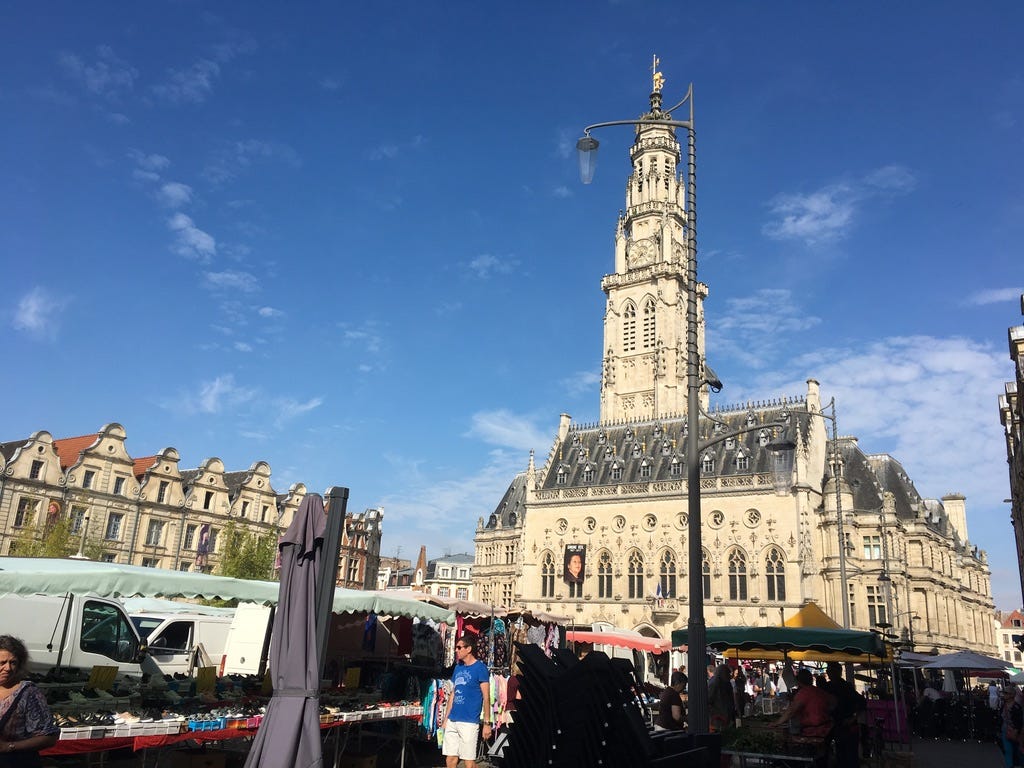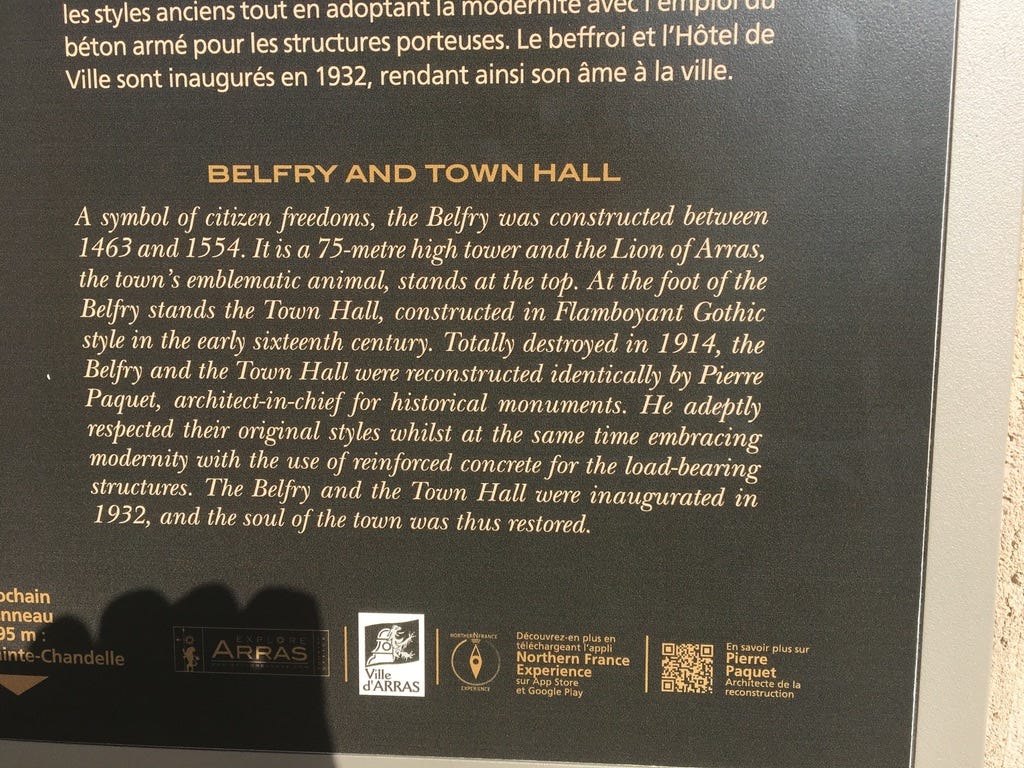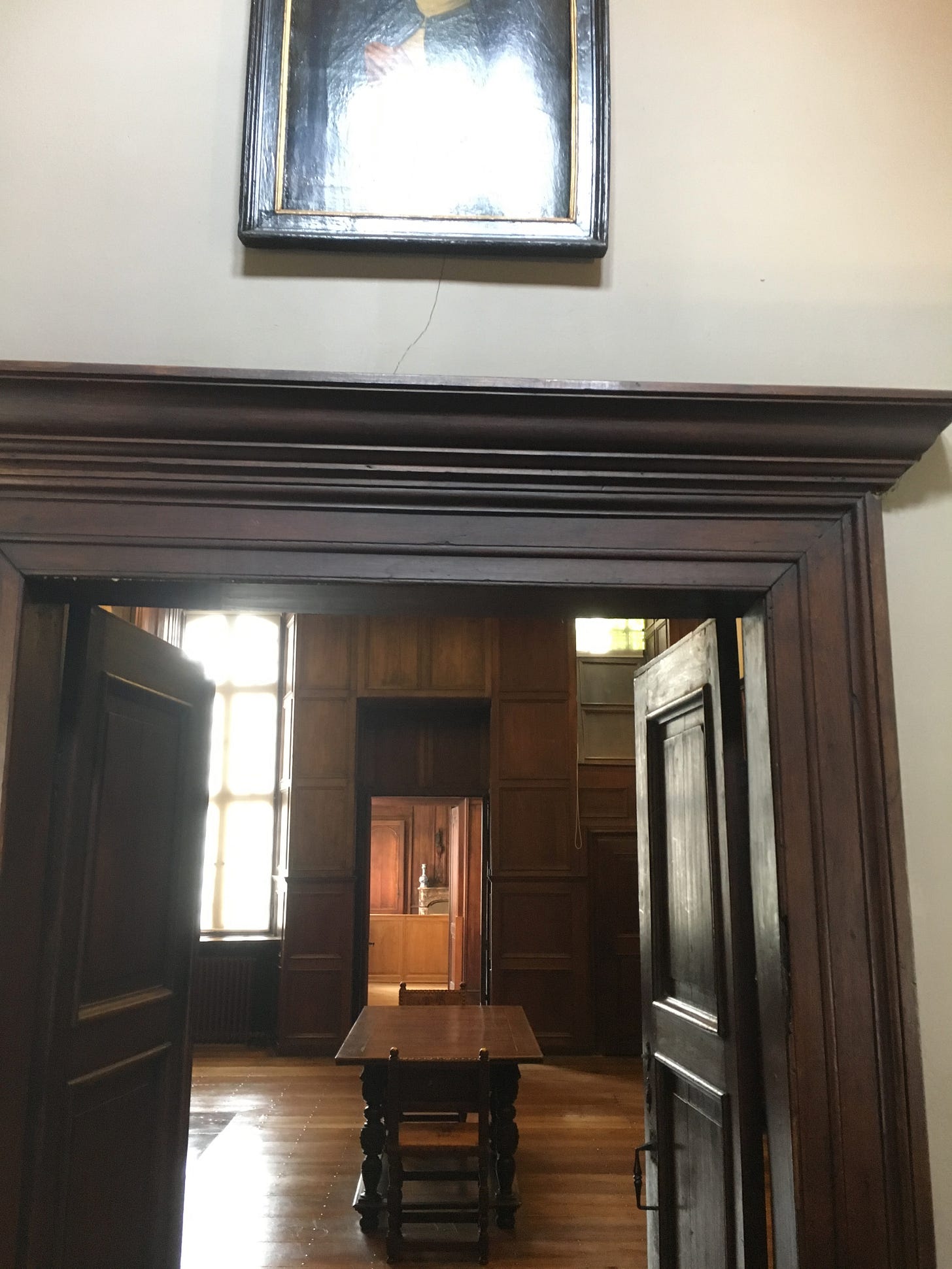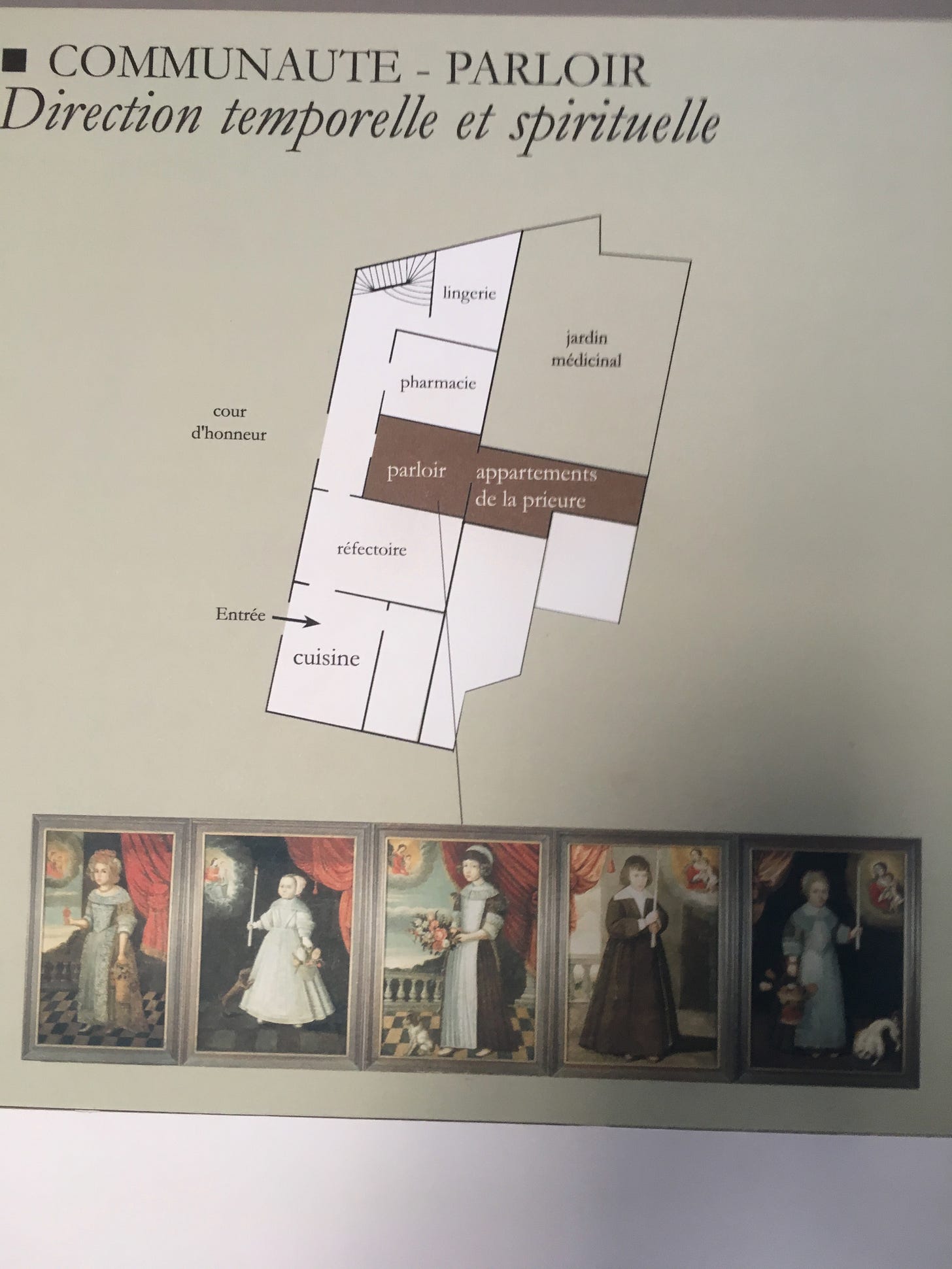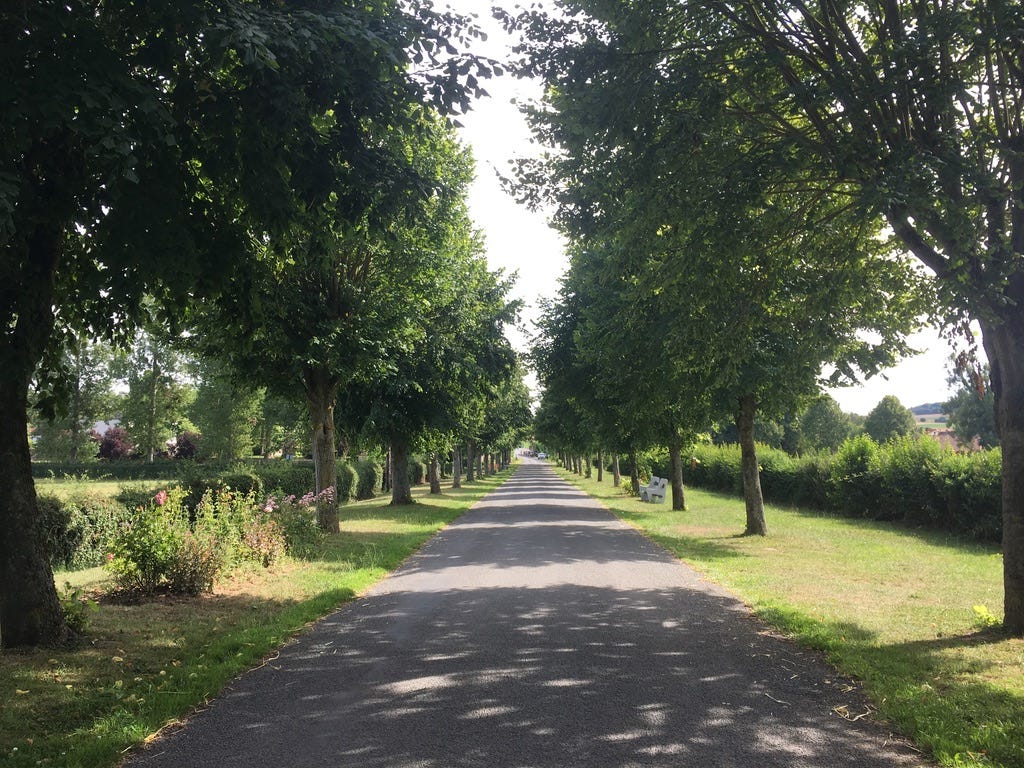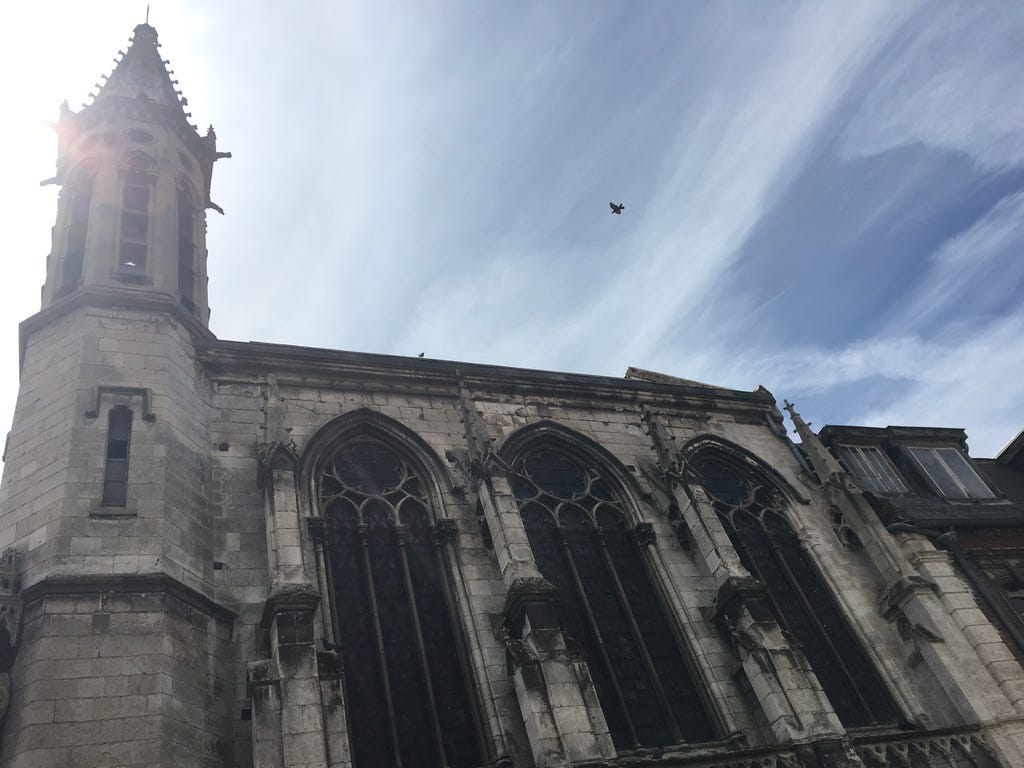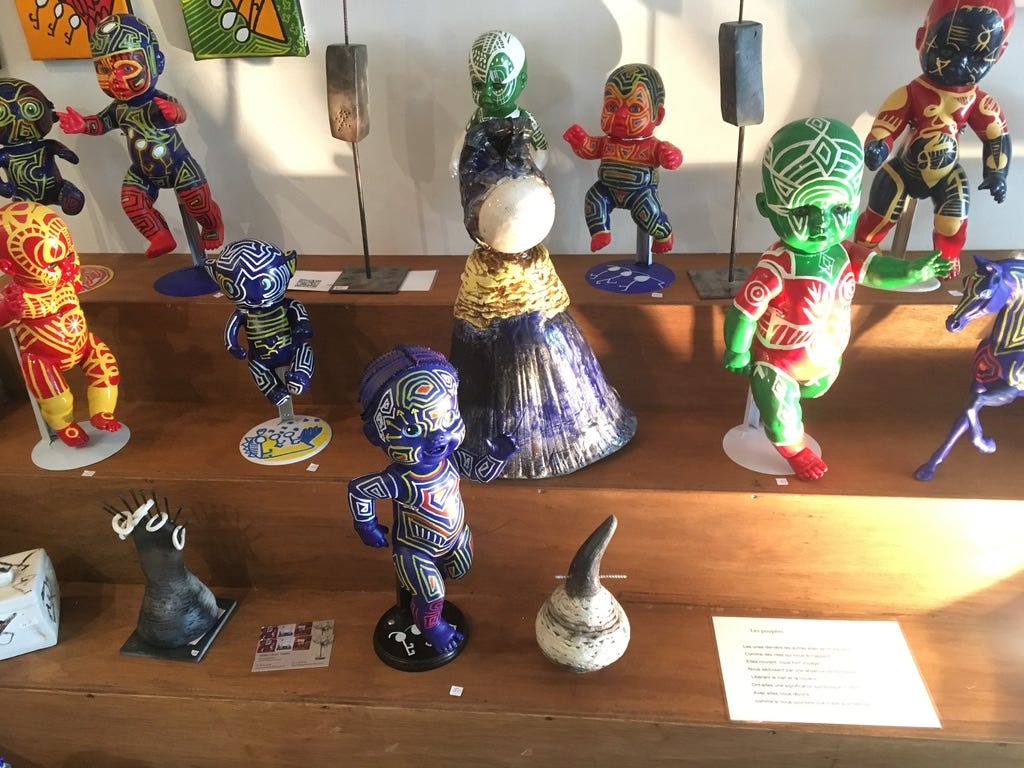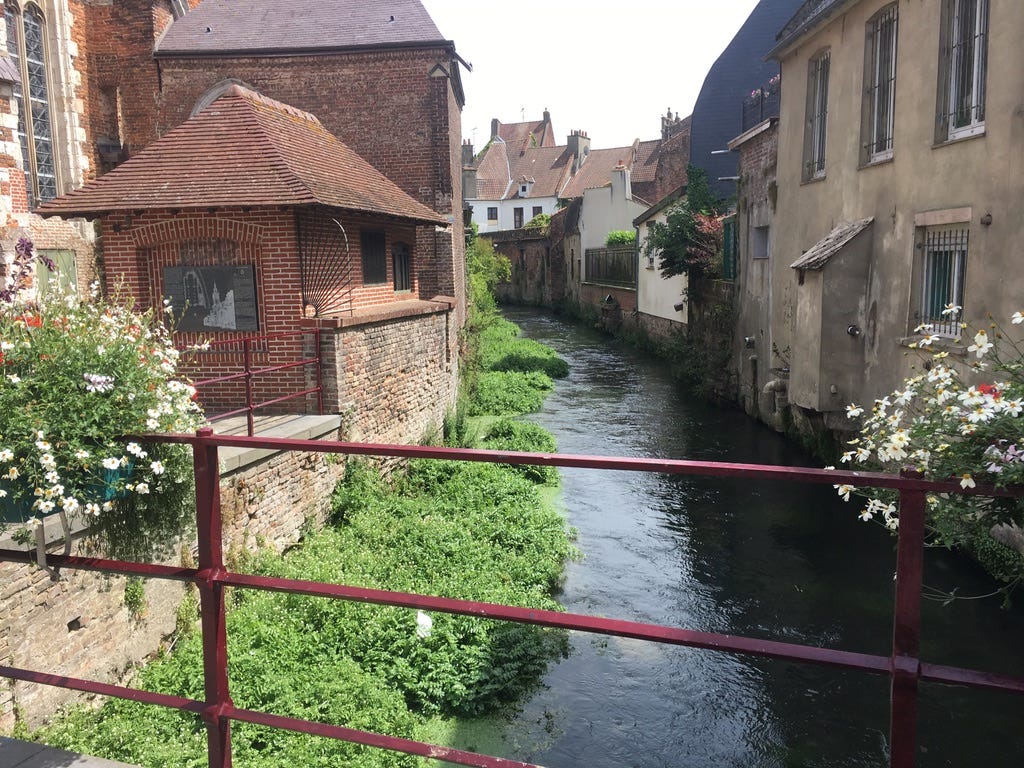“Captial! Adieu, Chevalier.“
“Adieu, Countess.”
“Commend me to the cardinal.”
“Commend me to Satan.”
Milady and Rochefort exchanged a smile and separated. An hour afterward Rochefort set out at a great gallop; five hours after that he passed through Arras.
Dumas
2017
While staying with Donna and Nik, I took a day to visit Lille and Arras on the train. Both grand cities in Milady’s day and, obviously, as Lille was the place of her branding, I could not miss either. Arras has a dramatic town square where there has been a market for hundreds of years.
It would have been part of the Netherlands in 1600, as part of the Habsburg Empire. Known for wool and tapestry, it is why Polonius was stabbed in the Arras. Most of the buildings were rebuilt after the first world war but retained a certain Flemish flavour. I bought fruit at the market tents and pondered how we rebuild over the past. To improve? To mend? To replace? Because they need saving? Because it’s been bombed?
Milady and her young priest must have walked to get to Lille, catching rides, having adventures. I wondered if he might have been gay, unable to stand celibacy? No, for surely priests were in the right place to enjoy expression of their sexuality - comfy in a dress after all. Yet, I could not understand why their relationship was not consummated. And what of the shame he brought upon his brother, the Executioner of Lille? And all to, finally, kill himself? If he admired Anne’s beauty, wanted to raise her up and it was he who calculated she might even marry the Comte de Fere, then she was still innocent and lacked ambition and he was the calculating one. He, although young, had seen the world and knew what value her beauty would hold in high places. He sold the gold, not for himself necessarily, though he probably thought he might benefit from being near her, basking in reflected glory perhaps? Or superannuation? What if he only pretended to be her protector, yet slyly offered her to the highest bidder? Is he the one with an eye for the main chance?
She did not denounce him in the end because she did love him in her way. I can’t mess with her final moments but I think she would have wanted a quiet word with the executioner to explain that she loved his brother too. But they wouldn’t let her speak.
She was Richelieu’s puppet, with Rochefort as her spy master. Richelieu and Louis XIV benefited from her actions. She worked for the glory of La France and Richelieu would not care about her death. He would say, ‘Why did you let yourself be caught?’
Cloaks and daggers, that’s what we want.
In Lille I had no help from the Tourist Information Centre. I suspect the guide was impatient to get to his lunch. Not only did he suggest the museums were too modern or shut, but also he wasn’t interested in a small piece of time like the first twenty five years of the seventeenth century. So, I was let loose.
I wandered around the old town and, following subconscious signs and portents, walked straight into a Catholic nunnery hospital, Musee de l’Hospice Comtesse. After it had burned down in the 16th century, it was rebuilt, the kitchen area featuring newfangled 17th Century blue and white Dutch tiles. I had to look past these modern imports to try to find the skeleton, the structure that might have been there in Milady’s day. There were a few paintings of the times, a lovely landscape of Lille but rebuilding has taken my time away.
The Prioress’s office, lined with wood panels, with extraordinary portraits of dead children, would stand as a model for Anne’s visits to the Priory Office.
A linen press, which I took to be a printing press at first, was a large wooden and metal construction in the middle of one of the ground floor rooms. I wonder which came first? There would have been olive oil presses, and apple cider presses in the monasteries, but when was it decided it would be best to use the augur to smooth bedclothes and tablecloths?
Was it women who needed to keep things in order? Linens were incredibly important and a sign of wealth. There was no ironing the bed sheets. They were dried out on a grassy field. So, it was used in order to smooth them, flatten them and make sure they stayed pressed while in storage.
This is the linen part of the world. When you did washing you washed most of the stuff from the cupboards. The sunny drying days were limited.
Linen is grown near Hesdin - I saw the fields laid low but just missed the plants coming into themselves. Blue flower on a tall thin leafy stem. The entire plant is pulled out rather than cut. It’s a labour intensive crop.
What could Anne have known about linen? Did the convent grow linen? How could this information compare to wool?
On my day off from Working Away (possibly a relief for Nik and Donna?) I wandered the 5km into Hesdin town, strolling down the tree-lined streets past farms, silent in the sunshine.
Stopped in a park to eat my sandwich and then found some spires to guide me. Looking centuries old, that’s no guarantee around here, a church on Rue d’Ancien Temple - proving just how ancient it all was just by name.
On the outskirts of the township, there in the sunshine, was a plaque commemorating the walls of Hesdyn. It had been a walled city, a fort, protecting the Holy Roman Empire from the French. You could still see ditches and mounds. A design showed the shape of the walls; they had designed Hesdyn, as a star shape (see previous post). The Duke of Burgundy, Charles Quint, that’s Charles V, Grand Emperor of the Holy Roman Empire, once had a chateau here, famed for the garden. One of the local villages is still named Le Parcq as a result.
On my way into the town, over the little waterways built into the fabric of the town, I noticed a gathering of market tables and a smattering of arty people. One table held lavender bags marked with ‘Paris’ and another table featured both pictures and large plastic dolls painted with bold geometric patterns in almost Mexican vibrant colours. The dolls were babies, nude and painted so fiercely they looked like disco tribal drama.
I found an impressionist retrospective by a painter called Daniel Helle. He was packing a painting, making a net of string. He asked if I was an artist? (Way to flatter a gal!) We upheld a patchwork conversation of shattered Franglais whereby he said he would not have sold a painting to a couple who had come in for a perfunctory look before haughtily leaving, taking the price list with them. He said they did not have merit. They were only interested in investment. I, on the other hand, had merit. I looked understanding.
Was I sure I was not an artist?
Ah, Monsieur, I hope I am on some level, I always wanted to be; strange how things go round and round; performer, writer, film maker, and it’s true, I want to make art somehow. But I think he was more interested in my artistic wallet.
Helle told me about the other workshops but I didn’t really understand as I set off across the Plaza d’Armes and found myself in an exhibition of three different painters. There was a festival of art in town! A large cheerful man (a name like Freti) with a jingling bracelet of pale jade beads made swirling patterns like light breaking through clouds of piled up bright colours and then he swirled sections with a compass somehow, flattening a crop circle in the billows of unrestrained colour. They were cheerful and energetic but it was another artist’s work, woodwork pictures, that I found engrossing. Carvings that were coloured, almost like jigsaws. Beautiful work. There was yet another vibrant painter, the originator of the tribal glo-paint dollies.
It turned out the Hesdin Council has donated five spaces to local artists for the summer. Taking a leaf from the Australian Newcastle ‘Renew’ policy, Freti told me they’d been seeing about 50 people a day through his gallery. Every four weeks they change the exhibition. He gave me an informative booklet and away I went to see the other venues. I met Koki, with purple henna hair and an intense aspect who liked Magritte and offered a hard political piece about refugees with sewn lips together with other work with a lighter, more colourful, shape theme. After two more places with mixed works, I found my way to a small gallery that seemed to be the centre of the web; Domé’s space may have been the size of a garage but it was stacked with evocative generous paintings. His bold, dark work sat well with some of Helle’s older pieces. I recognised one of the places on the tree-lined road I had just walked through. I enjoyed the time by myself, recognising I like to be able to digest and contemplate things I am not able to absorb at the moment they happen. I find I can’t quite keep up with everything around me. Sometimes I just need to be by myself and absorb.
Same as it ever was, same as it ever was (Letting the days go by)
Once in a lifetime (Let the water hold me down)
Letting the days go by (Water flowing underground)
Into the blue again




